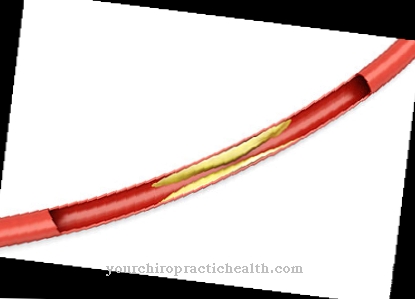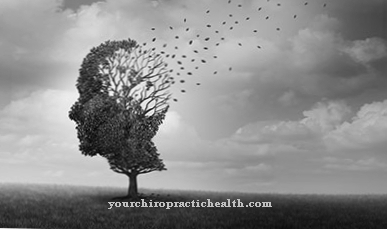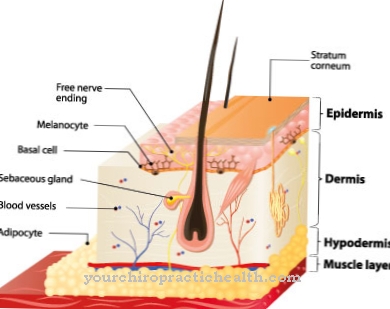Of the Pseudohypoparathyroidism shows the same symptoms as normal hypoparathyroidism without parathyroid hormone deficiency. The calcium level in the blood is too low and the level of phosphate is too high. Despite a normal or even increased concentration, the parathyroid hormone cannot develop its effect.
What is pseudohypoparathyroidism?

© reichdernatur - stock.adobe.com
Of the Pseudohypoparathyroidism, also Martin Albright Syndrome, is characterized by the same symptoms as hypoparathyroidism. The term hypoparathyroidism can be used as Parathyroid hormone deficiency which is caused by an underactive parathyroid gland. The prefix “pseudo” means “as if” and indicates that the parathyroid hormone is not working properly at a normal concentration of this hormone.
The parathyroid hormone regulates the calcium and phosphate concentration in the blood serum. The action of this hormone releases calcium from the bones when needed, while promoting the excretion of phosphate via the kidneys. When the level of calcium in the blood decreases or the need for it increases, the production of parathyroid hormone from the parathyroid glands is stimulated.
With the release of calcium from the bones, however, the release of phosphate automatically increases, because the main material of the bones consists of calcium phosphate. However, increased phosphate concentrations in turn inhibit the further release of calcium. Therefore, the parathyroid hormone also ensures the inhibition of phosphate absorption via the kidneys.
This means that more phosphate is excreted in the urine. Balanced calcium and phosphate levels are crucial for the electrolyte balance, which is responsible for the normal transmission of stimuli in muscle and nerve cells.
causes
Pseudohypoparathyroidism is thus characterized by a reduced effect of sufficient parathyroid hormone. As with classic hypoparathyroidism, this leads to hypocalcemia (calcium deficiency) and hyperphosphataemia (excess phosphate) in the blood. The result is increased stimulus transmission and states of excitement with neurological failures.
When it comes to the mode of action of the parathyroid hormone, it is not only important to have the correct concentration, but also the smooth functioning of all intermediate steps in the development of its effects. For a hormone to work, it needs to dock on a corresponding receptor. This receptor mediates the effect of hormones or other bioactive substances and thus brings them to their expression.
However, if a receptor is not working properly, the hormone, here the parathyroid hormone, cannot fulfill its function. The same failures occur as with a real deficiency of parathyroid hormone. The corresponding defects in the parathyroid hormone receptors are genetic. The processes at these switching points are complicated and varied, so that there are four different possibilities for malfunctions.
In type Ia pseudohypoparathyroidism, the proportion of G protein in the parathyroid hormone receptor complex is reduced. Type Ib is directly characterized by a defect in the PHT receptor. A defect in the catalytic unit of the parathyroid hormone receptor leads to pseudohypoparathyroidism of type Ic. Finally, in type II the receptor is intact. However, the intracellular answer is missing here.
Symptoms, ailments & signs
In addition to the deformations of the body structure, the symptoms of pseudohypoparathyroidism and hypoparathyroidism are characterized by hypocalcemia. The physique of the sick is characterized by short stature and shortening of the metacarpal and metatarsal bones. The hypocalcemia produces the symptoms of tetany.
This leads to paresthesia, paw positions of the hands, equinus position of the feet and cramps in the feet and hands. Furthermore, there is an increased willingness to reflex (hyperreflexia). This leads to an over-excitability of the muscle and nerve cells. The Chvostek's sign and the Trousseau test are positive.
In the Chvostek sign, when the facial nerve is tapped, the facial muscles contract. The Trousseau test is characterized by a spasmodic contraction of the forearm muscles with the hands in paws after applying and inflating a blood pressure cuff on the upper arm. The spasms can also manifest themselves in individual organs.
This then leads to biliary colic, cramping of the heart or lungs. Hair loss, cataracts, congestive papilla or dry skin can also occur as further symptoms. In severe cases, calcium deposits can build up in the brain, leading to headaches and increasing dementia.
Diagnosis & course of disease
The clinical picture of pseudohypoparathyroidism usually leads initially to the suspected diagnosis of hypoparathyroidism. The parathyroid hormone concentration is examined via laboratory tests. If this is normal, it is usually pseudohypoparathyroidism.
However, this must in turn be differentiated from what is known as pseudopseudohypoparathyroidism in a differential diagnosis. In pseudo-hypoparathyroidism, the calcium metabolism is normal, but the activity of the Gsa protein is reduced.
Complications
Pseudohypoparathyroidism produces symptoms similar to those of hypoparathyroidism. The same applies to the complications that arise with both diseases. The main symptoms are hypocalcemia and hyperphosphataemia, which are the main causes of various complications. Hypocalcaemia can be asymptomatic. But it can also lead to symptoms such as tetany, increased reflex readiness and low heart rate.
In severe cases, cardiac arrhythmias and cardiac insufficiency occur, which represent a great risk of cardiac arrest with failure of the cardiovascular system. Tetany involves cramps in the hands and feet that can lead to the paws of the hands and equinus position of the feet. If hypocalcaemia persists, mental health problems often arise, which are manifested in symptoms such as depression, moodiness, or anxiety.
Since phosphate is formed to a greater extent in addition to calcium, calcium phosphate precipitates in the vessels, with regulation mechanisms ultimately resulting in lower calcium and increased phosphate levels in the blood. The calcium phosphates precipitated in this reaction lead in particular to calcification of the brain.
The calcium deposits in the brain cause severe headaches and in extreme cases can also develop dementia. The calcium and phosphate values can be easily adjusted during therapy. However, pseudohypoparathyroidism is incurable because it is genetic. The shape anomalies of the joints and the short stature cannot be influenced therapeutically.
When should you go to the doctor?
Pseudohypoparathyroidism should always be treated by a doctor. The disease can lead to various complications, and the person concerned does not heal itself. Treatment by a doctor is therefore essential. As a rule, the doctor should be consulted if the person concerned suffers from short stature.
Various limbs are greatly shortened, so that severe restrictions and complaints can occur in everyday life. The short stature is mostly noticed in the course of the child's development. Pseudohypoparathyroidism must also be treated if the person is suffering from various muscle complaints. There may be pain in the muscles for no particular reason.
A visit to a doctor is also necessary if the disease leads to heart problems, dementia or dry skin. If the heart complaint is not treated in good time, the patient's life expectancy may be limited. In most cases, pseudohypoparathyroidism can be diagnosed by a pediatrician or a general practitioner. For further treatment, however, the help of specialists is necessary.
Treatment & Therapy
Since pseudohypoparathyroidism is genetic, this disease cannot be treated causally. Only symptomatic therapies to adjust the calcium metabolism are possible. The physical impairments such as short stature and shape anomalies cannot be treated. A normal calcium level can only be adjusted with medication.
This is done through the oral administration of calcium supplements in combination with vitamin D. In the event of a tetany attack, calcium sometimes has to be injected intravenously. Constant monitoring of calcium and phosphate levels is necessary. Long-term calcium administration can lead to the formation of kidney stones. The administration of a thiazide diuretic may be necessary to avoid an increased calcium concentration in the urine. The calcium excretion should also be checked regularly.
prevention
Pseudohypoparathyroidism is a genetic disease. For this reason, there can be no recommendation for its prevention. In the case of familial accumulation, however, genetic counseling and examinations can be used to assess the risk for the offspring. It should be noted, however, that the genetic basis for all forms of pseudohypoparathyroidism is not known.
Aftercare
Pseudohypoparathyroidism is a genetic disorder, which means that the symptoms are only followed up symptomatically and a cure is impossible. Drug treatment helps stop the calcium metabolism. For this purpose, calcium supplements are taken in combination with vitamin D. In cases of tetany attacks, calcium must be temporarily administered intravenously.
The calcium intake can lead to the formation of kidney stones. To avoid this, it may also be necessary to take diuretic medication. The calcium excretion should always be monitored. Check-ups at regular intervals by a specialist are recommended. These are used to control calcium and phosphate levels and adjust medication if necessary.
Once diagnosed, a healthy lifestyle should be followed. Eating a healthy diet with foods rich in calcium helps reduce the deficiency naturally. The absorption of vitamin D through foods such as porcini mushrooms, oatmeal or sweet potatoes also has a positive effect on the body. A low-phosphate diet should also be sought by reducing protein-containing products, legumes and nuts.
Physical impairments such as short stature or shortened metacarpal or metatarsal bones are not treatable and can lead to severe restrictions in everyday life. The overexcitability of the muscles can be trained through physiotherapy. Relaxation techniques such as yoga or meditation also help to cope better with the disease.
You can do that yourself
The possibilities of self-help are very limited in pseudohypoparathyroidism. The symptoms of the disease are extensive and cannot be sufficiently minimized with your own actions.
The affected person can support his organism positively by optimizing the food intake. Food containing calcium should be consumed more intensively. The aim is to naturally reduce the existing calcium deficiency. Therefore, various calcium-containing products should be consumed daily, spread over the day. At the same time, nutrients containing phosphates should be avoided. Protein-containing products, pulses and nuts should therefore be avoided when preparing the menu. Otherwise the excess of phosphate already produced by the body would be additionally increased. Vitamin D intake is recommended to further improve health. Mushrooms or chanterelles contain the vitamin and should be on the menu regularly.
Dealing with over-excitability of the muscles can be promoted through targeted training or relaxation techniques. In physiotherapy, the person concerned learns various exercises that should be pursued independently outside of the therapy appointments. In addition, methods such as yoga, meditation or autogenic training help to strengthen mental strength. In everyday life, this can be helpful in coping with the disease. Well-being is stabilized and stressors are reduced.




.jpg)

.jpg)

















.jpg)



